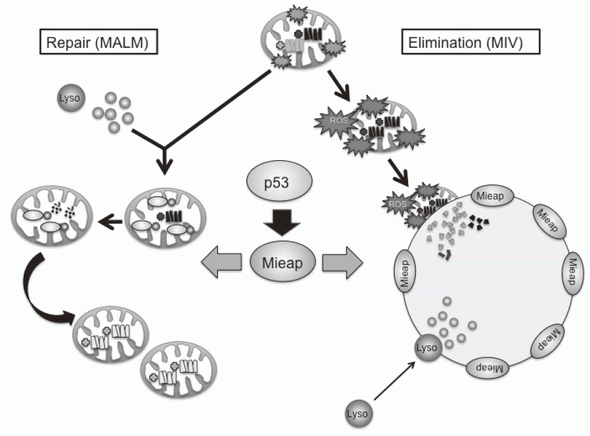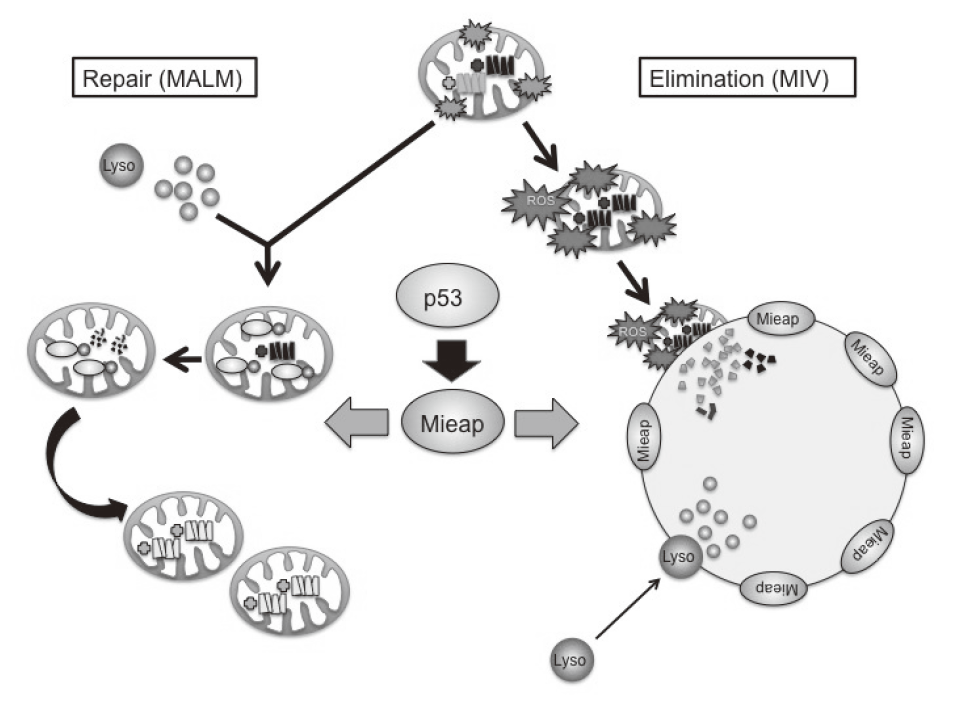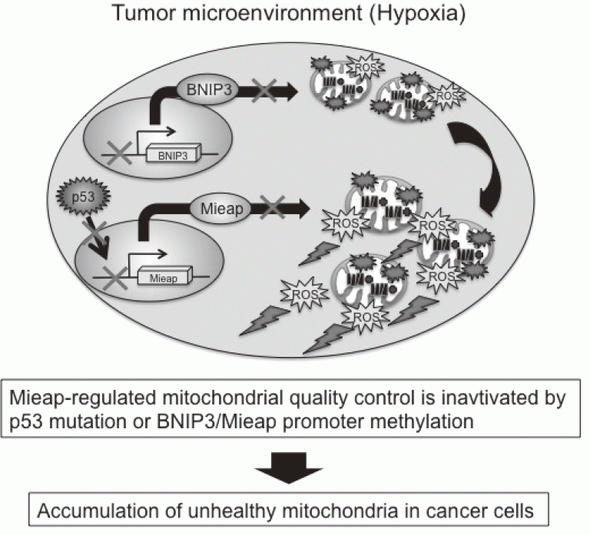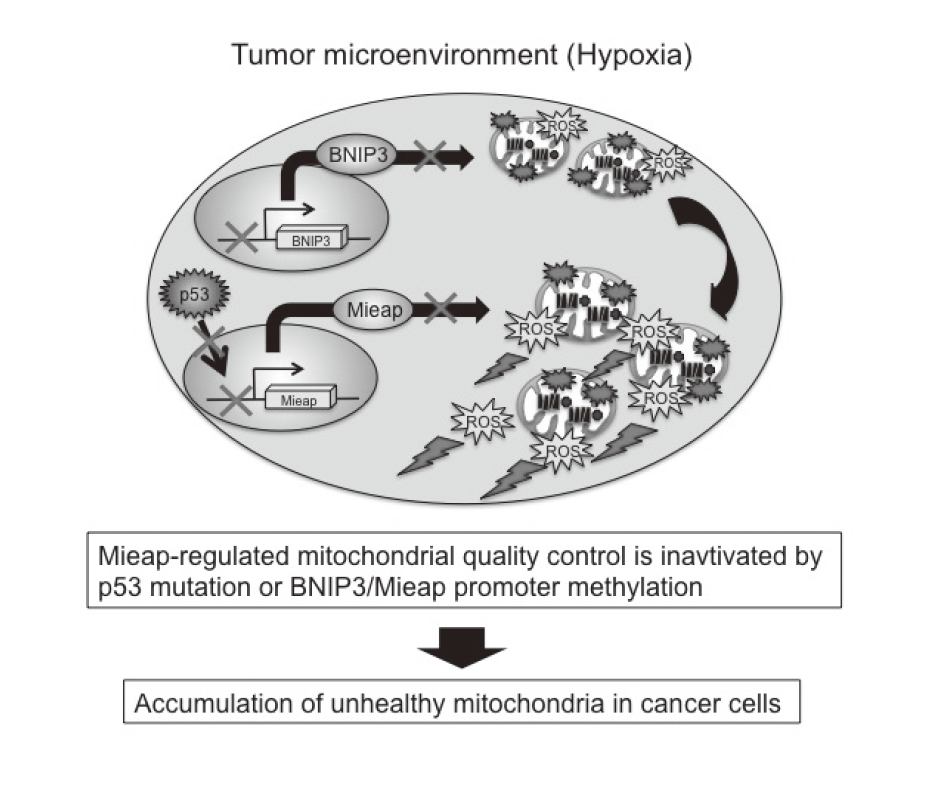HOME > Publication & Reports > Annual Report 2016 > Research Institute
Division of Cancer Biology
Hirofumi Arakawa, Yasuyuki Nakamura, Masayuki Tsuneki, Yoko Sagami, Ruri Nakanishi, Chieko Haga, Katsuko Honjo, Tomonori Aikawa, Makoto Yamamoto
Research activities
1.Mieap-regulated mitochondrial quality control
Mieap controls mitochondrial quality via two distinct novel mechanisms. One of the mechanisms has been designated MALM for Mieap-induced accumulation of lysosome-like organelles within mitochondria (PLoS ONE 6: e16054, 2011). In this mechanism, Mieap induces the accumulation of intramitochondrial lysosomal proteins in order to eliminate oxidized mitochondrial proteins in response to mitochondrial damage. This leads to a decrease in reactive oxygen species generation and an increase in mitochondrial ATP synthesis activity, implying MALM plays a role in repairing unhealthy mitochondria.
BNIP3 and NIX, mitochondrial outer membrane proteins, two Mieap-interacting proteins mediate the translocation of lysosomal proteins from cytosol into mitochondria during MALM by forming an unknown pore in the mitochondrial double membrane (PLoS ONE 7: e30767, 2012). 14-3-3γ mediates the degradation of oxidized mitochondrial proteins within mitochondria during MALM (Scientific Reports 2: 379, 2012).
Alternatively, the other mechanism has been designated MIV for Mieap-induced vacuole (PLoS ONE 6: e16060, 2011). When MALM is inhibited, Mieap induces a vacuole-like structure, MIV. The MIV engulfs the damaged mitochondria and accumulates lysosomes, leading to the degradation of unhealthy mitochondria. MIV likely represents a novel mechanism for mitochondrial autophagy, also called "mitophagy". Therefore, Mieap controls mitochondrial quality by repairing or eliminating unhealthy mitochondria via MALM or MIV generation, respectively (Figure 1).
2.Mieap-regulated mitochondrial quality control is frequently inactivated in human cancer
The accumulation of unhealthy mitochondria results in mitochondrial dysfunction, which has been implicated in aging, degenerative diseases and cancer. The Mieap-regulated mitochondrial quality control (MQC) was found to be frequently inactivated by p53 mutations or Mieap/BNIP3 promoter methylation in more than 70% of primary cancer tissues of colorectal cancer patients, leading to accumulation of unhealthy mitochondria and high levels of mitochondria reactive oxygen species (ROS) generation.
The elevated mitochondrial ROS causes oxidative damage to DNA, RNA, protein, lipid and so on. This induces genomic instability. The mitochondrial ROS contribute to tumor growth, epithelial-to-mesenchymal transition, cancer invasion, cancer metastasis, tumor angiogenesis through the activation of HIF-1, NF-kB, MMPs, AKT, Erk1/2, JNK, and so on. Therefore, the Mieap-regulated MQC is a tumor suppressor for colorectal cancer (Figure 2).
In order to further evaluate the clinical significance of the Mieap-regulated MQC in human cancer, the status of p53, Mieap, and BNIP3 are being examined in primary cancer tissues of breast, gastric, pancreatic, lung, and liver cancer patients.
3.Mieap-deficient cancer animal model
To clarify the in vivo role of the Mieap-regulated MQC in tumorignenesis, the Mieap knockout mice were generated in our division. Using the Mieap knockout mice, the Mieap-deficient ApcMin/+ mice were also generated and analyzed in order to elucidate the role of Mieap in colorectal cancer tumorigenesis (Scientific Reports 5: 12472, 2015).
Interestingly, the Mieap-deficient ApcMin/+ mice exhibited remarkably reduced lifespans compared with those of ApcMin/+ mice. Furthermore, a substantial increase in the number and size of intestinal polyps was found in the Mieap-deficient ApcMin/+ mice. Histopathologically, intestinal tumors in the Mieap-deficient ApcMin/+ mice clearly exhibited advanced grades of adenoma and adenocarcinomas. Unhealthy mitochondria dramatically accumulated in the tumor cells and generated high level of ROS in the Mieap-deficient ApcMin/+ mice. These results suggest that the Mieap-regulated MQC pathway has a critical role in the suppression of intestinal tumor in vivo.
4.Development of new cancer preventive/diagnostic/therapeutic methods through targeting cancer-specific unhealthy mitochondria
Unhealthy mitochondria are dramatically and specifically accumulated in cancer cells due to inactivation of the Mieap-regulated MQC. Therefore, our working hypothesis proposes that cancer-specific unhealthy mitochondria owing to inactivation of the Mieap-regulated MQC may be very attractive and promising targets for the development of new cancer preventive/diagnostic/therapeutic methods. Now, in order to identify new cancer preventive/diagnostic/therapeutic targets, the nature and characteristics of these cancer-specific unhealthy mitochondria are being explored by metabolome, transcriptome, and proteome analyses in our division.
Education
To obtain knowledge and skill for cancer research, students attend lectures and seminars, and attend and/or practice research meetings, journal clubs, scientific meetings, etc. These practices will enable students to develop an ability to conduct their studies as an independent cancer researcher in the future. To obtain skills to carry out experiments that are required for cancer research, students belong to one of our research groups, and conduct their own studies under the guidance of the instructor and/or staff. Students perform various experiments involved in genetics, gene technology, biochemistry, cellular biology, molecular biology, physiology, experimental animal, pathology, genomic/epigenomic/proteomic analysis, imaging, next generation sequencing, etc.
Future prospects
Analyses of clinical cancer tissues and various cancer-mouse models enable us to understand the actual role of the Mieap-regulated MQC in human cancer formation, progression, invasion, and metastasis. Finally, we will be able to establish a solid foundation for the development of new strategies for cancer prevention, diagnosis, and therapy in the future.
List of papers published in 2016
Journal
1.Kamino H, Nakamura Y, Tsuneki M, Sano H, Miyamoto Y, Kitamura N, Futamura M, Kanai Y, Taniguchi H, Shida D, Kanemitsu Y, Moriya Y, Yoshida K, Arakawa H. Mieap-regulated mitochondrial quality control is frequently inactivated in human colorectal cancer. Oncogenesis, 4:e181, 2016




